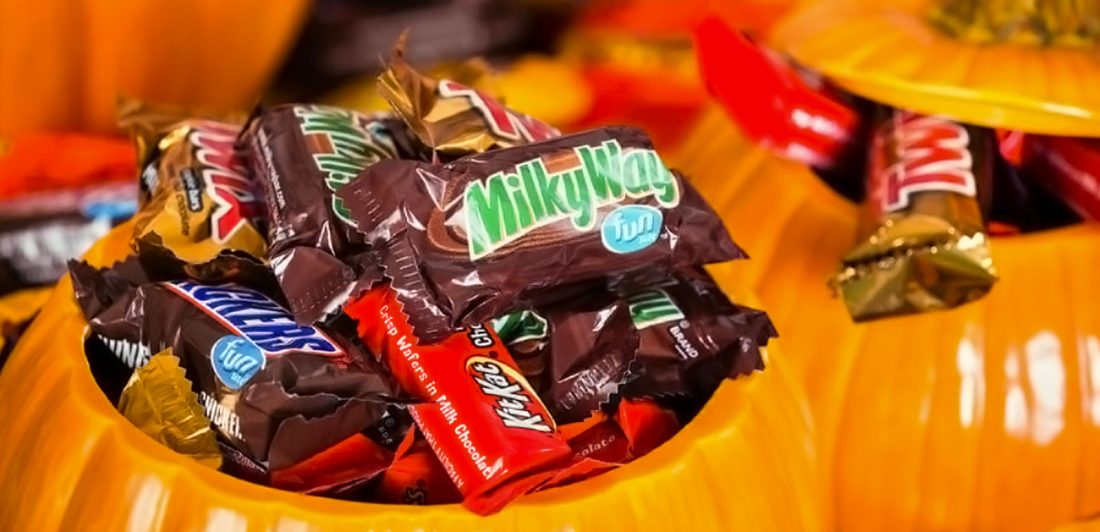Today, Halloween urban legends from the 20th century seem ridiculous and cliche. But the Internet and the 24-hours news cycle have made it easy to scare parents in far more wicked ways compared to the days of old.
Halloween is especially ripe to spread fear and panic among parents. Every other day of the year, we encourage our kids not to accept candy from strangers, look both ways when crossing the street, and not go out after dark. But on Halloween night, all of this caution disappears. We dress our children up, take them out at dusk and chaperone them from house to house collecting candy from strangers. Essentially, Halloween is the epitome of the crisis of parenthood. How do you let your child enjoy childhood in a world where bad things happen to unsuspecting, innocent people?
Halloween Urban Legend Origin Stories
After trick-or-treating, parents dump the buckets of Halloween candy collected by their kids and begin the tedious job of inspecting each individual piece. During these checks, parents are looking for anything that looks suspicious. To kids, this often seems like an overreaction when they’re ready to dig into their goodies. However, the steps parents take to keep their kids safe are necessary because of the malevolent work of a few bad but isolated Halloween incidents. Whether we know it or not, parents’ fears around Halloween are based on some truth.
Halloween of 1982: A Year of Product Tampering
Many parents’ Halloween fears are rooted in true stories, and there is one year that encapsulates the sensationalism of bad actors on Halloween. In 1982, Halloween went completely off the rails. Several scary incidents happened in succession and paralyzed the country with fear. Halloween costume and candy sales plummeted, as many parents kept children home that year. Halloween of 1982 was basically canceled.
The first nightmare of 1982, was the Chicago Tylenol murders. In September and October of 1982, seven people died after taking Tylenol acetaminophen tablets. The unknown assailant used cyanide to poison the tablets taken by unsuspecting victims, including a 12-year-old. The Chicago Tylenol murders led to the complete overhaul in the packaging of over-the-counter substances. No one was ever arrested for the crime, and hundreds of product tampering cases were recorded in the month following the attack.
Another instance occurred on October 29, 1982, when a straight pin hidden in a chocolate bar cut the cheek of a 28-year-old Long Island resident. That same day, a group of New Jersey schoolchildren were hospitalized after ingesting Tootsie Rolls at a school party that had been sprinkled with phencyclidine, more commonly known as PCP.
Also in October 1982, a man in New Hampshire was arrested over suspicion of attempting to insert broken glass into an apple.
1982 was such a bad year for product contamination that the director of the New York City Department of Health’s Poison Control Center said, “we are approaching an epidemic in the contamination of products” resulting in “extreme” caution “almost bordering on paranoid.”
Sharp Objects in Treats…a Real Threat?
There is very little evidence that razor blades in candy or apples are a widespread issue. However, there have been isolated cases of children biting into a chocolate bar and being surprised with a sharp metal object. In 2000, a Minneapolis man named James Joseph Smith was arrested for sticking needles into the Snickers bars he handed out. While no serious injuries were reported, there have been real documented cases of pins, needles and razors found in chocolates.
The Candy Man Can… Give Out Poisoned Candies?
A prevalent candy urban legend that persists to this day is a fear of poison-laced Pixy Sticks. While it has become a bloated myth, it actually has its roots in a true story. The Candy Man wasn’t an evil stranger wanting to kill neighborhood children. It was Ronald O’Bryan, a father in Deer Park, Texas whose goal was to collect insurance money.
In 1974, O’Bryan devised a plan to add cyanide to 21-inch Pixy Sticks and give them to children. O’Bryan added cyanide to five Pixy Sticks to make it look like all children in his community were at risk of ingesting tainted candy, but he only intended to kill his own children. Police theorized that he had given candy to the other children to cover up his crime.
O’Bryan’s eight-year-old son Timothy was the first child to ask for candy and choose the Pixy Stick. An hour later, Timothy was dead from what doctors discovered was cyanide poisoning. News of the death sent panic through the Houston suburb. Luckily, none of the other children consumed the candy. Eventually, officials determined that O’Bryan, not a nearby neighbor, was responsible for his son’s death. O’Bryan was executed in 1984 but maintained his innocence.
How to Check for Product Tampering
While it’s unlikely that your neighbors will hand out dangerous or deadly treats, there is no such thing as being too safe. Child injuries occur when parents let their guard down. For that reason, it’s best to look out for dangers in even the most innocent of activities.
Keep your children safe this Halloween by using the following candy safety guidelines:
No Snacking
Your kids may be desperate to get into their candy buckets and start eating their treats right away. However, tell your children to wait until they get home so that you can properly inspect the candy and ensure their safety.
Inspect All Wrapped Treats
This includes commercially wrapped treats. As demonstrated above, while product tampering rarely occurs, it can happen. The Food and Drug Administration recommends that parents look for the following to determine whether or not they are safe to consume:
- Unusual appearance
- Discoloration
- Tiny pinholes
- Tears in wrappers
- Packaging that looks like it has been opened
Parents should throw away anything that looks suspicious.
Toss the Homemade Goodies
Most people participating in Halloween activities know better than to give out homemade treats. However, if your children receive a homemade treat, it’s better to just throw it away. You don’t know what ingredients the treat contains.
Small, Hard Candies and Gum
If you have very young children, be sure to remove candy that can be choking hazards. This includes, gum, peanuts, hard candy, and small toys.
Happy Halloween from The Carlson Law Firm!
Exercising an abundance of caution around the Halloween season is necessary. No matter how you choose to celebrate Halloween, allowing your children to enjoy the day should involve a level of hyper-awareness to keep them safe. Remember to inspect candy, look both ways, wear reflective gear or glow sticks, and have fun!





